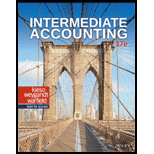
Intermediate Accounting, 17th Edition
17th Edition
ISBN: 9781119503682
Author: Donald E. Kieso, Jerry J. Weygandt, Terry D. Warfield
Publisher: WILEY
expand_more
expand_more
format_list_bulleted
Question
Chapter 16, Problem 3E
To determine
Convertible Bonds: Bonds are long-term debts issued by a corporation. They can be issued at a discount or premium. Convertible bonds are long-term debts issued by a corporation carrying a fixed rate of interest which can be converted into securities of the corporation after a specific period of time. These debts offer a double benefit to the holder in terms of guaranteed return of interest and principal and a right to convert the debt into ownership participation.
To prepare: To prepare a
Given Information: Bonds: $500,000.
Premium on Bonds: $7,500.
Conversion ratio: 20 shares.
Par value: $50.
Expert Solution & Answer
Want to see the full answer?
Check out a sample textbook solution
Students have asked these similar questions
During FY 2024 Matrix Industries had total manufacturing costs of $563,000. Their cost of goods manufactured for the year was $598,000. The January 1, 2025 balance of the Work-in-Process Inventory is $57,000. Use this information to determine the dollar amount of the FY 2024 beginning Work-in-Process Inventory.
hello teacher give me answer with calculation
Mahavir Electricals started the year with total assets of $310,000 and total liabilities of $200,000. During the year, the business recorded $520,000 in revenues, $360,000 in expenses, and dividends of $60,000. What is the net income reported by Mahavir Electricals for the year?
Chapter 16 Solutions
Intermediate Accounting, 17th Edition
Ch. 16 - Prob. 1QCh. 16 - 2. Briefly explain why corporations issue...Ch. 16 - 3. Discuss the similarities and the differences...Ch. 16 - 4. Bridgewater Corp. offered holders of its 1,000...Ch. 16 - 5. Explain how the conversion feature of...Ch. 16 - Prob. 6QCh. 16 - Prob. 7QCh. 16 - Prob. 9QCh. 16 - Prob. 10QCh. 16 - Prob. 11Q
Ch. 16 - Prob. 12QCh. 16 - Prob. 13QCh. 16 - Prob. 14QCh. 16 - Prob. 15QCh. 16 - Prob. 17QCh. 16 - Prob. 18QCh. 16 - Prob. 19QCh. 16 - Prob. 20QCh. 16 - 21. Explain how convertible securities are...Ch. 16 - Prob. 22QCh. 16 - Prob. 23QCh. 16 - Prob. 24QCh. 16 - Prob. 25QCh. 16 - Prob. 26QCh. 16 - Prob. 1BECh. 16 - Prob. 2BECh. 16 - Prob. 3BECh. 16 - Prob. 4BECh. 16 - Prob. 5BECh. 16 - Prob. 7BECh. 16 - Prob. 1ECh. 16 - Prob. 2ECh. 16 - Prob. 3ECh. 16 - Prob. 19ECh. 16 - Prob. 1PCh. 16 - Prob. 1CACh. 16 - Prob. 3CACh. 16 - Prob. 4CACh. 16 - Prob. 5CACh. 16 - Prob. 6CACh. 16 - Prob. 1CECh. 16 - Prob. 2CECh. 16 - Prob. 3CECh. 16 - Prob. 4CECh. 16 - Prob. 1CRCCh. 16 - Prob. 1ISTCh. 16 - Prob. 2ISTCh. 16 - Prob. 3ISTCh. 16 - Prob. 4ISTCh. 16 - Prob. 5ISTCh. 16 - Prob. 1ICACh. 16 - Prob. 2ICACh. 16 - Prob. 3ICACh. 16 - Prob. 4ICACh. 16 - Prob. 5ICACh. 16 - Prob. 6ICACh. 16 - Prob. 7ICACh. 16 - Prob. 8ICACh. 16 - Prob. 9ICACh. 16 - Prob. 13ICACh. 16 - Prob. 14ICA
Knowledge Booster
Learn more about
Need a deep-dive on the concept behind this application? Look no further. Learn more about this topic, accounting and related others by exploring similar questions and additional content below.Similar questions
- Archer Corp. prepared a fixed budget of 80,000 direct labor hours, with estimated overhead costs of $400,000 for variable overhead and $120,000 for fixed overhead. Archer then prepared a flexible budget of 72,000 labor hours. How much are total overhead costs at this level of activity? Helparrow_forwardI am searching for the correct answer to this financial accounting problem with proper accounting rules.arrow_forwardDirect labor : 18750 Direct materials : 14250arrow_forward
- I am trying to find the accurate solution to this general accounting problem with appropriate explanations.arrow_forwardI am looking for help with this general accounting question using proper accounting standards.arrow_forwardPlease provide the accurate answer to this general accounting problem using appropriate methods.arrow_forward
arrow_back_ios
SEE MORE QUESTIONS
arrow_forward_ios
Recommended textbooks for you

 AccountingAccountingISBN:9781337272094Author:WARREN, Carl S., Reeve, James M., Duchac, Jonathan E.Publisher:Cengage Learning,
AccountingAccountingISBN:9781337272094Author:WARREN, Carl S., Reeve, James M., Duchac, Jonathan E.Publisher:Cengage Learning, Accounting Information SystemsAccountingISBN:9781337619202Author:Hall, James A.Publisher:Cengage Learning,
Accounting Information SystemsAccountingISBN:9781337619202Author:Hall, James A.Publisher:Cengage Learning, Horngren's Cost Accounting: A Managerial Emphasis...AccountingISBN:9780134475585Author:Srikant M. Datar, Madhav V. RajanPublisher:PEARSON
Horngren's Cost Accounting: A Managerial Emphasis...AccountingISBN:9780134475585Author:Srikant M. Datar, Madhav V. RajanPublisher:PEARSON Intermediate AccountingAccountingISBN:9781259722660Author:J. David Spiceland, Mark W. Nelson, Wayne M ThomasPublisher:McGraw-Hill Education
Intermediate AccountingAccountingISBN:9781259722660Author:J. David Spiceland, Mark W. Nelson, Wayne M ThomasPublisher:McGraw-Hill Education Financial and Managerial AccountingAccountingISBN:9781259726705Author:John J Wild, Ken W. Shaw, Barbara Chiappetta Fundamental Accounting PrinciplesPublisher:McGraw-Hill Education
Financial and Managerial AccountingAccountingISBN:9781259726705Author:John J Wild, Ken W. Shaw, Barbara Chiappetta Fundamental Accounting PrinciplesPublisher:McGraw-Hill Education


Accounting
Accounting
ISBN:9781337272094
Author:WARREN, Carl S., Reeve, James M., Duchac, Jonathan E.
Publisher:Cengage Learning,

Accounting Information Systems
Accounting
ISBN:9781337619202
Author:Hall, James A.
Publisher:Cengage Learning,

Horngren's Cost Accounting: A Managerial Emphasis...
Accounting
ISBN:9780134475585
Author:Srikant M. Datar, Madhav V. Rajan
Publisher:PEARSON

Intermediate Accounting
Accounting
ISBN:9781259722660
Author:J. David Spiceland, Mark W. Nelson, Wayne M Thomas
Publisher:McGraw-Hill Education

Financial and Managerial Accounting
Accounting
ISBN:9781259726705
Author:John J Wild, Ken W. Shaw, Barbara Chiappetta Fundamental Accounting Principles
Publisher:McGraw-Hill Education
Earnings per share (EPS), basic and diluted; Author: Bionic Turtle;https://www.youtube.com/watch?v=i2IJTpvZmH4;License: Standard Youtube License